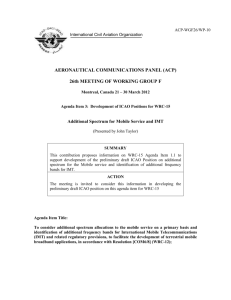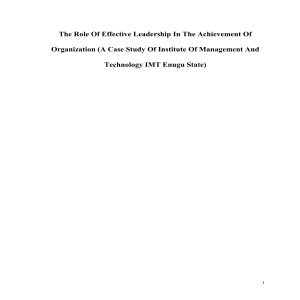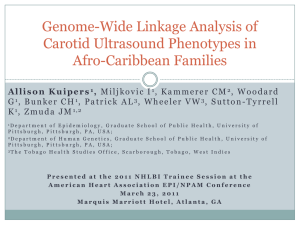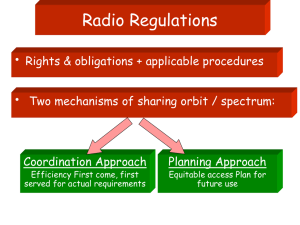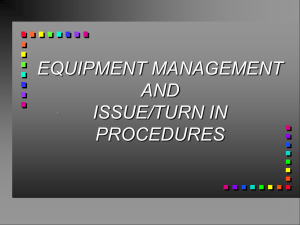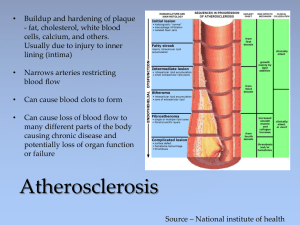imt in the years 2020 and beyond and considerations on spectrum
advertisement
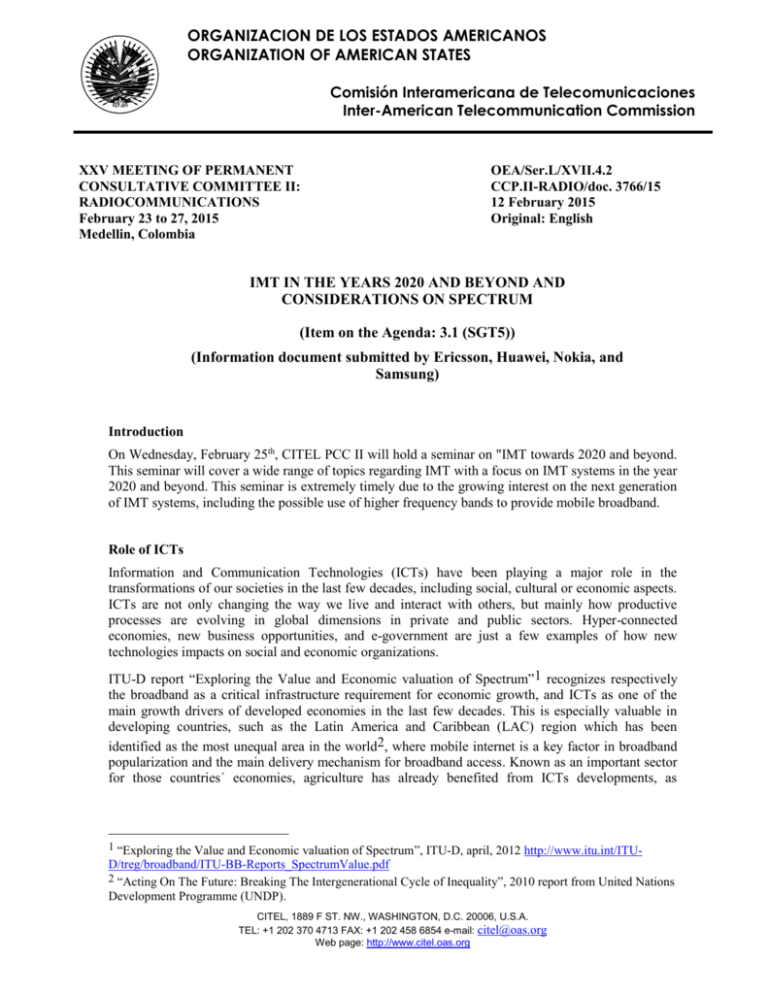
ORGANIZACION DE LOS ESTADOS AMERICANOS ORGANIZATION OF AMERICAN STATES Comisión Interamericana de Telecomunicaciones Inter-American Telecommunication Commission XXV MEETING OF PERMANENT CONSULTATIVE COMMITTEE II: RADIOCOMMUNICATIONS February 23 to 27, 2015 Medellin, Colombia OEA/Ser.L/XVII.4.2 CCP.II-RADIO/doc. 3766/15 12 February 2015 Original: English IMT IN THE YEARS 2020 AND BEYOND AND CONSIDERATIONS ON SPECTRUM (Item on the Agenda: 3.1 (SGT5)) (Information document submitted by Ericsson, Huawei, Nokia, and Samsung) Introduction On Wednesday, February 25th, CITEL PCC II will hold a seminar on "IMT towards 2020 and beyond. This seminar will cover a wide range of topics regarding IMT with a focus on IMT systems in the year 2020 and beyond. This seminar is extremely timely due to the growing interest on the next generation of IMT systems, including the possible use of higher frequency bands to provide mobile broadband. Role of ICTs Information and Communication Technologies (ICTs) have been playing a major role in the transformations of our societies in the last few decades, including social, cultural or economic aspects. ICTs are not only changing the way we live and interact with others, but mainly how productive processes are evolving in global dimensions in private and public sectors. Hyper-connected economies, new business opportunities, and e-government are just a few examples of how new technologies impacts on social and economic organizations. ITU-D report “Exploring the Value and Economic valuation of Spectrum”1 recognizes respectively the broadband as a critical infrastructure requirement for economic growth, and ICTs as one of the main growth drivers of developed economies in the last few decades. This is especially valuable in developing countries, such as the Latin America and Caribbean (LAC) region which has been identified as the most unequal area in the world2, where mobile internet is a key factor in broadband popularization and the main delivery mechanism for broadband access. Known as an important sector for those countries´ economies, agriculture has already benefited from ICTs developments, as 1 “Exploring the Value and Economic valuation of Spectrum”, ITU-D, april, 2012 http://www.itu.int/ITU- D/treg/broadband/ITU-BB-Reports_SpectrumValue.pdf 2 “Acting On The Future: Breaking The Intergenerational Cycle of Inequality”, 2010 report from United Nations Development Programme (UNDP). CITEL, 1889 F ST. NW., WASHINGTON, D.C. 20006, U.S.A. TEL: +1 202 370 4713 FAX: +1 202 458 6854 e-mail: citel@oas.org Web page: http://www.citel.oas.org improved quality of meteorological information to farmers or reducing transaction costs of intermediaries3. During different Summits of Americas, coordinated by the OAS, the importance of ICTs for the development of countries in Americas has been confirmed. In the last Strategic Plan for CITEL for 2014-2018, it is clearly expressed the “vision” of using the ICT’s to reduce the digital divide and to integrate the American States into the Global Information Society, enabling and accelerating social, economic and environmentally sustainable development for all the region’s inhabitants. IMT in 2020 and Beyond In 2020 and beyond, wireless communication services will have an even bigger impact on our economies due to improved quality of service and user experience, faster and ubiquitous networks, and new market segments such as machine-to-machine (M2M) and Internet of Things (IoT). A massive amount of wireless devices and sensors measuring the environment, communicating data and status reports will help to reduce energy and water consumption, while improving the management of critical infrastructure. High-resolution security cameras monitoring public spaces, wireless sensors for biological and chemical hazard detection, smart roads (vehicular-to-road communication), vehicle traffic control, and automated processes will drive efficiency and productivity, thereby affecting the way buildings, cities4, logistics and factories are run. Future mobile services and applications will also expand into new market segments, such as smart grid, e-health, telemedicine, new tools for distance learning, online gaming (wirelessly delivered with high-resolution graphics), 4K and 8K video mobile streaming services (even on a crowded subway/bus and in public places), virtual reality, and augmented reality. Big Data analytics is an ascending area, making it possible to identify and combine relevant data to enable businesses for better decisionmaking and execution. All the applications mentioned above, as well as other still unforeseen, will continue to drive the mobile broadband data traffic volume of future.5 6 The next generation of mobile communication technologies can support future mobile traffic demands by operating in efficient and wider bandwidths. Contiguous wide system bandwidth (approximately 500 MHz to 1 GHz or more) will be considered as a critical factor for efficient delivery of ultra-high end user bit rates. Bands above 6 GHz ITU-R Working Party 5D has been developing Report ITU-R M.[IMT.ABOVE 6 GHz], which studies the technical feasibility of bands above 6 GHz for future IMT. WP5D plans to finalize this Report at its June 2015 meeting. The results are promising. In addition, many experiments conducted recently 3 “The Role of Information and Communication Technologies (ICTs) in the Improvement of Agricultural Value Chains”, FAO (Food and Agriculture Organization of the United Nations), 2011, http://www.fao.org/docrep/017/ap851e/ap851e.pdf 4 According to estimates of Population Divison of Department of Economics and Social Affairs from United Nations, urbanization rates of Latin America countries averages at least in 80% by 2030, http://esa.un.org/unpd/wup/default.aspx 5 OECD (2012), “Machine-to-Machine Communications: Connecting Billions of Devices”, OECD Digital Economy Papers, No. 192 at 8, OECD Publishing. http://dx.doi.org/10.1787/5k9gsh2gp043-en. 6 Cisco, The Zettabyte Era – Trends and Analysis (2013) at 2, available at http://www.cisco.com/en/US/solutions/collateral/ns341/ns525/ns537/ns705/ns827/VNI_Hyperconnectivity_WP. pdf. 687303451 06.02.16 1 (and many others currently underway) with positive results from both industry and academia researches are emphasizing on the possible usage and benefits of implementing IMT in higher frequency bands in the future. Administrations (e.g. UK, Germany, Sweden, Korea, China, Japan), research and industry associations (e.g. METIS, IMT-2020 Promotion Group, 5G Forum, iJOIN Forum, WWRF, 4G Americas, TIA, etc), and academia (e.g. Surrey University and New York University) are considering higher frequency bands for future IMT. WRC-19 Agenda Item Discussions WRC-15 agenda item 10 calls for recommendations to the Council on items for inclusion in the agenda for the next World Radiocommunications Conference (WRC-19). In other Regions, discussions have started on the topic of a possible new agenda item related to the use of bands above 6 GHz for IMT for the deployment of Future IMT systems. For example, APT and CEPT are already conducting in-depth discussions and developing their preliminary views on the proposal for a WRC-19 new agenda item addressing identification to IMT in the bands above 6GHz for the future IMT, which would be completed by July and September, 2015, respectively. This document provides information on global movements of IMT for 2020 and beyond to make CITEL and its Member States and Associate Members aware of these discussions. Annexes: 1. Information regarding a WRC-19 Agenda Item on IMT ANNEX 1 Information regarding a WRC-19 Agenda Item on IMT Background Given recent technological advances, industry and researchers have done considerable work investigating the possibility of implementing IMT in frequency bands above 6 GHz. In particular, these bands have the potential to provide wide, contiguous channels for future IMT systems. Based upon these developments, Administrations and other members have developed proposals for a preliminary WRC-19 Agenda Item seeking to provide an IMT identification for future IMT systems. In particular, APT and CEPT WRC-15 preparatory groups are working to develop a proposal for a WRC-19 agenda item to address the future needs of IMT: these proposals would include spectrum in higher frequency bands. 687303451 06.02.16 2 Global studies on IMT in higher frequencies As the responsible group for IMT matters within the ITU, ITU-R Working Party 5D has been studying the future of IMT. It is well-know that frequency bands below 6 GHz that are being considered under WRC-15 agenda item 1.1. Complementary to this work, WP 5D also has recognized the need for providing future IMT services not only in the frequency bands below 6 GHz, but also the potential of new technologies to provide new high capacity services in frequency bands above 6 GHz in the future. WP 5D studies address future IMT technology and services in bands above 6 GHz in reflecting the evolution trends of technology. The following relevant studies have been developed in ITU-R WP 5D: - Report ITU-R M.2320 (November 2014) addresses trends in the terrestrial IMT technology aspects and enablers considering the timeframe 2015-2020 and beyond. - Draft new Recommendation ITU-R M.[IMT.VISION] (June 2015) recommends the framework and objectives of the future IMT for 2020 and beyond including various trends, usage scenarios and capabilities. - Draft new Report ITU-R M.[IMT.ABOVE 6 GHz] (June 2015) studies the technical feasibility of IMT in the bands above 6 GHz. It includes aspects such as potential new IMT radio interface technologies, appropriate operation system approaches for above 6 GHz, the possible impacts of propagation characteristics in higher frequency bands, components, antenna techniques, deployment architectures and results of simulations, experiments and performance tests. - Draft new Report ITU-R M.[IMT.BEYOND2020.TRAFFIC] (June 2015) provides result of mobile broadband data traffic estimation for the period of 2020-2025/2030. Additionally, other 5G research organizations and projects worldwide have been studying the use of frequency bands above 6 GHz for future IMT. For example, many participants in the “Workshop on research views of IMT beyond 20207”, hosted by ITU in February 2014 during the 18th meeting of ITU-R WP5D, expressed interest in these bands. 3GPP is worldwide organization addressing the development of technical specifications and standards for mobile communications. During the “3GPP RAN workshop on Release 12 and onwards8” held in June 2012, some members voiced their interests in the possibilities and needs of higher frequency bands for future mobile broadband. More recently, a proposal (RP-1421969 and RP-14219710) to study on further evolution beyond LTE-Advanced using frequency spectrum above 6 GHz was reviewed during the 66th of 3GPP TSG RAN meeting on December 2014. Both industry and academia are systematically announcing their vision on future IMT using higher frequency bands through several white papers and research studies. Several projects, including some sponsored by different governments, are already underway. Therefore, the objective of this potential WRC-19 agenda item would be to consider using particular frequency ranges above 6 GHz (which would be defined in the agenda item) for mobile broadband applications including IMT whilst also investigating the most appropriate way to protect existing users in these bands. 7 http://www.itu.int/dms_pub/itu-r/oth/0a/06/R0A060000630001MSWE.docx 8 http://www.3gpp.org/ftp/workshop/2012-06-11_12_RAN_REL12/ 9 http://www.3gpp.org/ftp/tsg_ran/TSG_RAN/TSGR_66/Docs/RP-142196.zip 10 http://www.3gpp.org/ftp/tsg_ran/TSG_RAN/TSGR_66/Docs/RP-142197.zip 687303451 06.02.16 3 Economic benefits of IMT Numerous studies from ITU, universities, multilateral organizations (such as World Bank) and industry associations (as 3G Americas and GSMA) explore in-depth the economic benefits from broadband, and especially mobile broadband11. A World Bank Report has found that in low- and middle-income countries every 10 percentage point increase in broadband penetration accelerates economic growth by 1.38 percentage points: more than in high-income countries and more than for other telecommunications services. A common GSMA, Deloitte and Cisco report has shown that the effect of doubling mobile data usage per 3G connection had the effect of 0,5% increase in growth rate of GDP per capita in 14 (developed and developing) countries searched during 2008 and 2011. According to the same study, Brazil had a 0,6% increase in growth rate of GDP per capita for doubling the data use per 3G connection and Mexico had a 0,4% in the same period. Another report from GSMA about the mobile economy in Latin America has found that the total (direct and indirect) contribution from of handset manufacturers, infrastructure providers, network carriers, retailers industry and application developers was of 4,1% of whole GDP region in 2013. The widespread use of mobile technology in the region increased business productivity, generating an additional US$147 billion in value added in 2013, or 2.5% of GDP12. With these figures in mind, future IMT services and applications might have an even bigger impact in Americas region as a whole, especially in Latin America and Caribbean societies and economies. Service perspectives Motivated by new mobile devices, services and applications with increasing capabilities requiring higher data rate and extreme low latency experiences, IMT technologies will be widely deployed in densely populated and short-range areas in the near future. Machine to machine (M2M) and Internet of Things (IoT) applications, smart grid, online gaming, smart roads (inter-vehicular/ vehicular-to-road communication), 4K and 8K quality video streaming, are just a few examples from the wide range of future emerging services. These applications demand high performance and satisfactory Quality of Experience (QoE), so running at the same time in a specific area or at a specific time may cause serious capacity problems. To deal with this huge amount of data and traffic, an equivalent capacity of processing will be required simultaneously to deliver an acceptable Quality of Experience (QoE) for 11 “Exploring the Value and Economic valuation of Spectrum”, ITU-D, April, 2012 http://www.itu.int/ITU- D/treg/broadband/ITU-BB-Reports_SpectrumValue.pdf . “Spectrum Caps in the Americas delay Mobile Broadband Services”, 3G Americas, http://www.3gamericas.org/documents/2009_Spectrum_caps_in_Latin_America%20-%20May08.pdf: “In emerging economies, a 10% increase in mobile penetration boosts annual GDP growth by 1.2%; as mobile broadband repeats the productivity revolution of mobile phones, the global GDP impact could be a boost of 34%”. Lum, Tracy, "Mobile goes global: The effect of cell phones on economic growth and development" (2011). Honor’s Theses. Paper 4. Building Broadband – Strategies and Policies for Developing World by: Yongsoo Kim, Tim Kelly and Siddhartha Raja. “What is the impact of mobile telephony on economic growth?”, GSMA Deloitte and Cisco, 2011. page 2: “A doubling of mobile data use leads to an increase in the GDP per capita growth rate of 0,5 percentage points” (Cisco´s VNI Index for 14 countries). Regarding developing countries the report states that “a 10 per cent increase in mobile penetration increases Total Factor Productivity in the long run by 4.2 percentage points”. “Socio-economic impact of broadband in LAC countries”, Zaballos, A. G. and López-Rivas, R, BID, May, 2012 12 “The Mobile Economy: Latin America 2014”, GSMA. 687303451 06.02.16 4 users. For example, tens of Gbps data rate will be required to support 4K and 8K quality mobile video streaming service in real-time. Multi-Gbps data rate per user should be considered for future IMT services demanding QoE and high data rates. Those aspects, quality and speed, are essential requirements to be fulfilled by additional spectrum. In higher frequency bands such as that above 6GHz, the spectrum could potentially be made available to accommodate wide system bandwidths which allow efficient high data rate service delivery. Technology perspectives A variety of new devices, services and applications, especially those requiring higher data rate and real-time delivery, are expected. Capacity problems can arise in a specific area or at a specific time, affecting peak data rate, when a number of users will demand simultaneously high performance data services. Therefore, multi-Gbps data rate per user should be considered in the design and implementation of future IMT. The future mobile broadband services requiring QoE and high data rates will need access to additional spectrum to accommodate wide system bandwidths. Important technology advances have been recently developed and improved. These advances are important for the industry and are on commercial use by carriers in some regions of the world, including: - New advances in antenna technologies: However it may be difficult to increase the number of antenna elements in lower frequency bands because of the limitation of form factor size. It is much easier to accommodate the large number of antennas in the higher frequency bands. Carrier aggregation (CA) technology: Already in use in Asia and commercially introduced in the last months in some European countries, CA expands the operating bandwidth, maximises the data throughput and make wider bandwidths by aggregating the fragmented frequency bands in order to extend the limited spectrum resource available in lower frequency bands. The techniques involved have already been pushed to the limit of what might be practically and theoretically maximum possible considering existing IMT spectrum. At higher frequencies it is possible to implement higher order antenna arrays for use in higher frequency bands and to employ massive MIMO technologies with reasonable hardware form factors. The use of very high frequencies bands for mobile use has always been considered difficult, especially because of the large path loss and the fragile link in the bands above 6 GHz. Propagation losses between transmitters and receivers and the low diffraction effect can result that signals at higher frequencies do not reach the user under NLoS conditions. Despite those challenges, the small wavelength of higher frequency bands facilitates the narrow beamforming through a large number of antenna elements in smaller forms, building directional beams with large antenna array gain, thereby combating the propagation loss. In addition, it should be taken into consideration that higher frequencies with wider spectrum bandwidths could be overlaid with existing IMT networks, addressing extremely high user traffic demands in specific areas or at specific times. As a possible deployment scenario, bands below 6GHz would be focused on high mobility and large coverage data services, while bands above 6GHz could provide ultra-high data rate services. Dynamic beam steering techniques over short range connections would be under consideration in this scenario: higher gain (and perhaps adaptive) antenna systems at the base stations; beam steering arrays on the user terminals; and dynamic pointing of the base station beam(s) according to traffic demands. 687303451 06.02.16 5 The use of higher frequency bands represents an approach to deal with the densification resulting from small cells. These cells should provide the scalability and density needed for a consistent and smooth integration into a broader cellular network infrastructure. The technical feasibility of utilizing higher frequency bands for IMT are currently being studied in ITU-R WP 5D as well as in several global research projects, from both industry and academia. The detailed technical report on the technical feasibility of IMT in bands above 6 GHz feasibility, Draft New Report ITU-R M.[IMT.ABOVE 6 GHz], is scheduled to be finalized in June 2015 by ITU-R WP 5D. Spectrum perspectives A review of the Radio Regulations shows there are several frequency ranges from 6 GHz to 100 GHz capable of providing contiguous wide bandwidth from several hundred MHz to several GHz that are already allocated to the Mobile Service in all three ITU-R regions. Although many parts of this range are also allocated to the fixed service, satellite service and mobile service on a co-primary basis, it is important to consider additional spectrum in higher frequency bands for future IMT use to support the upcoming IMT services requiring higher performance The frequency range from 6 GHz to 100 GHz is a wide range for consideration. However, as defined in the current ITU Radio Regulations, a meaningful amount of the spectrum is already allocated to mobile service on a co-primary basis and could therefore be considered in the first instance. The precise frequency bands could be defined by ongoing research and studies. After that, the next step would be sharing studies with relevant other services. 687303451 06.02.16 6
